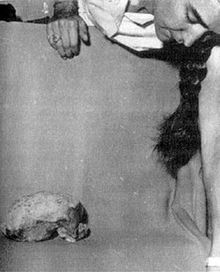Deep skull
Deep Skull ( English : deep, hidden skull ) is the name for a fossil skull from the Young Pleistocene . It was discovered in 1958 during a test excavation near the western entrance to the Great Niah Cave on Borneo Island ( Sarawak State , Malaysia ). The age of the skull has been dated between 45,000 and 39,000 years; it is therefore considered the oldest evidence of the presence of anatomically modern humans ( Homo sapiens ) on the Southeast Asian islands.
In the same layer as the skull and in its vicinity, two bones were also discovered from below the head, possibly attributable to the same individual. A corresponding lower jaw has not yet been discovered.
Dating
The fragments of the skull were discovered in 1958 at a depth of around 2.75 meters below the then cave floor. In the immediate vicinity of the fragments, there were charcoal remains, for which Professor Hessel de Vries from the University of Groningen calculated an age of 39,600 ± 1000 years before today (BP) using the radiocarbon method ( 14 C dating) , which is was reported as the likely age of the fossil. This dating remained controversial, however, as evidence of burial was known from more recent horizons and it cannot be ruled out that the skull was buried in deeper layers of the earth and thus in the vicinity of the fossil charcoal. For the correctness of the radiocarbon dating - that is, the evidence of charcoal in a 40,000 year old layer - the fact that a somewhat younger layer was dated to an age of 32,630 ± 700 years as early as 1957.
A first confirmed direct uranium-thorium dating of the fossil revealed a somewhat earlier age of 35,200 ± 2600 years. A new uranium-thorium dating of the fossil and, at the same time, the charcoal discovered in the vicinity finally (as of the end of 2017) showed an age of around 37,000 years with a range from 45,000 to 39,000 years ago.
In 2007 it was also reported that the find was unequivocally not buried, but presumably washed into a depression in the cave floor at the time, where it was concealed by other sediments that had washed in.
Find description

The exploration of the Niah Caves was started in 1954 by Tom Harrisson in collaboration with Barbara Harrisson . The skull had broken into numerous individual parts, and large areas of the left and right sides of the skull could no longer be found. For example, the largest fragment that appears complete after the reconstruction was put together from 23 fragments. The two right large molars M1 and M2 as well as several tooth sockets of the right and left upper jaw have also been preserved . The right 3rd large molar had not erupted.
The skull was first described in detail in 1960 by Don Brothwell in the Sarawak Museum's in-house magazine , whose curator Tom Harrisson was from 1947 to 1966. Brothwell suggested the skull could be attributed to a 15 to 17 year old adolescent. He also believed to recognize features that point to a phenotypic proximity to the Tasmanians and - more broadly - to the Negritos . This led to a scientific debate that lasted for decades about the importance of the skull for understanding the settlement history of anatomically modern humans in Southeast Asia.
In a detailed new description of the skull published in 2016, the authors came to the conclusion that the skull belonged to an adult woman who may have died between the ages of 40 and 50. Arguments for this interpretation of age were mainly the clearly visible wear and tear of the large molars, according to the authors, the graceful bone structure and the less pronounced attachment of the muscles speak for the gender.
According to the study, the skull is most similar to the indigenous Dayak living in Borneo today . Should this interpretation hold, it would speak for a continuous settlement of the island over the past 40,000 years.
literature
Kenneth AR Kennedy: The deep skull of Niah: An assessment of twenty years of speculation concerning ist evolutionary significance. In: Asian Perspectives. Volume 20, No. 1, 1977, pp. 32–50, full text (PDF)
Web links
- Ancient Deep Skull still holds big surprises 60 years after it was unearthed. On: theconversation.com from June 28, 2016 (with images of the skull and where it was found)
Individual evidence
- ↑ a b c d Darren Curnoe, Ipoi Datan, Paul SC Taçon, Charles Leh Moi Ung and Mohammad S. Sauffi: Deep Skull from Niah Cave and the Pleistocene Peopling of Southeast Asia. In: Frontiers in Ecology and Evolution. Online publication from June 27, 2016, doi: 10.3389 / fevo.2016.00075
- ^ A b Tom Harrisson: The Great Cave of Niah: A Preliminary report on Bornean Prehistory . In: Man , Volume 57, 1957, pp. 161–166, full text (PDF)
- ^ Bernard Wood : Wiley-Blackwell Encyclopedia of Human Evolution. Wiley-Blackwell, New York 2011, p. 547, ISBN 978-1-4051-5510-6
- ^ Graeme Barker et al .: The 'human revolution' in lowland tropical Southeast Asia: the antiquity and behavior of anatomically modern humans at Niah Cave (Sarawak, Borneo). In: Journal of Human Evolution. Volume 52, No. 3, 2007, pp. 243-261, doi: 10.1016 / j.jhevol.2006.08.011
- ^ Don Brothwell : Upper Pleistocene human skull from Niah Caves, Sarawak. In: Sarawak Museum Journal. Volume 9 (ns 15-16), 1960, pp. 323-349
- ^ Ancient 'Deep Skull' from Borneo full of surprises. On: eurekalert.org of June 27, 2016

